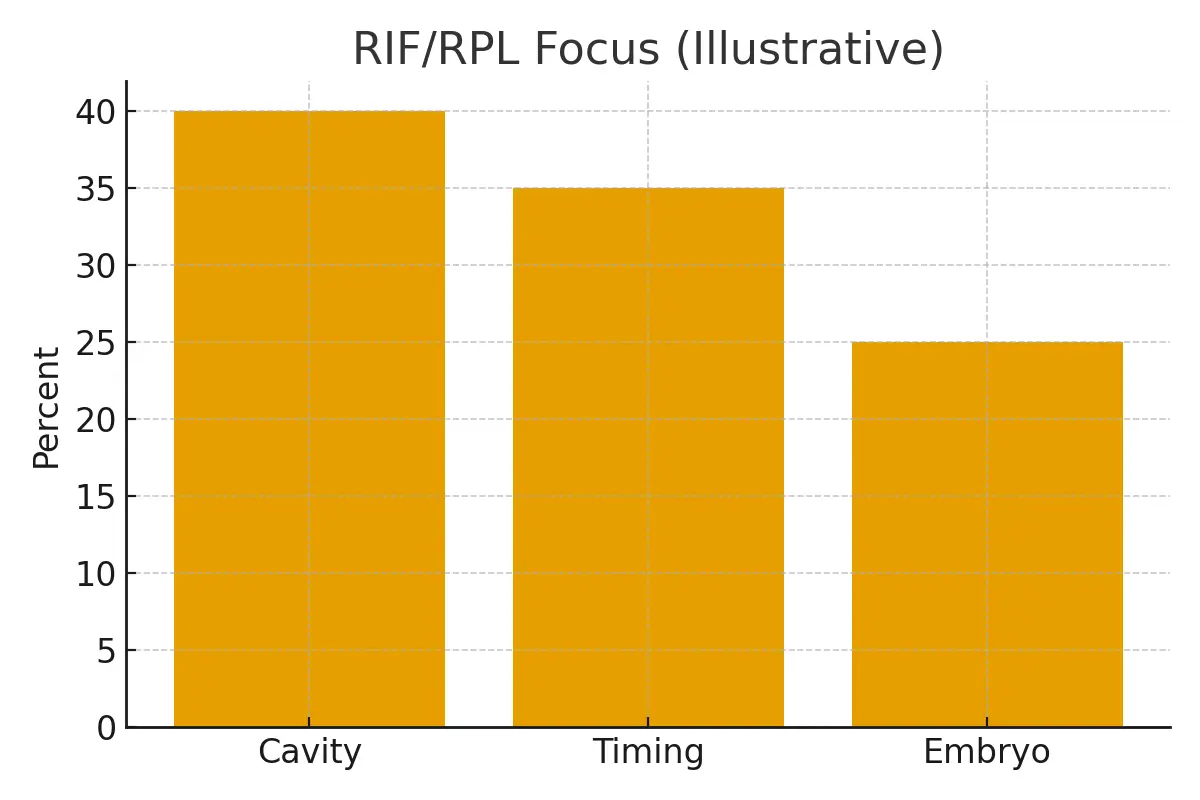
This article explains ERA, EMMA, and ALICE testing within the Uterine & Implantation (RIF/RPL) pathway. It highlights when these tools make a difference—and when they don’t—so you can protect outcomes, budgets, and timelines while moving forward with confidence.
What It Is
- ERA (Endometrial Receptivity Analysis): checks the exact timing of your “receptive window” for embryo transfer.
- EMMA (Endometrial Microbiome Metagenomic Analysis): looks at bacteria in the uterine lining to see if the environment is balanced for implantation.
- ALICE (Analysis of Infectious Chronic Endometritis): screens for harmful bacteria linked to chronic inflammation.
- In plain English: these tests try to find hidden reasons for implantation failure—but not everyone needs them.
Who It Helps
These tests may help if you have:
- Recurrent implantation failure (RIF) after good-quality embryos
- Recurrent pregnancy loss (RPL) with no clear cause
- Suspicion of infection or microbiome imbalance
- Irregular response to hormone preparation during frozen embryo transfers
They are less useful for first-time IVF patients or those without failed transfers.
Step-by-Step
- Baseline workup — rule out simpler issues first (uterine cavity, hormones, infection).
- Biopsy collection — tissue taken during a mock cycle or controlled timing.
- Lab testing — sample sent for ERA, EMMA, and/or ALICE as indicated.
- Results & adjustments — tailor progesterone start, treat infections, or rebalance microbiome.
- Transfer planning — only proceed once timing and uterine environment are optimized.
Pros & Cons
Pros:
- Can uncover hidden factors when standard tests look “normal.”
- May personalize transfer timing for better odds.
- Non-surgical and relatively low-risk.
Cons:
- Expensive and not always covered by insurance.
- Evidence is mixed—benefits may be modest.
- Adds time, especially if repeat biopsy is needed.
Costs & Logistics
- Line items: biopsy, lab fees, courier charges, antibiotics or probiotics (if needed).
- Insurance: rarely covered; often paid out of pocket.
- Cash flow: testing delays transfer by 1–2 months.
- Tracking: align testing cycle with clinic calendar to avoid rescheduling.
What Improves Outcomes
- Doing these tests only after failed transfers, not as routine for everyone.
- Pairing results with clinical history instead of treating labs in isolation.
- Confirming infections are cleared before embryo transfer.
- Using results to fine-tune transfer timing—not to overcomplicate cycles.
Case Study
A 35-year-old with 3 failed frozen transfers had an ERA test, which revealed her receptive window was 24 hours later than standard. After shifting progesterone timing, her next transfer worked. Here, the ERA changed her outcome, but she would not have needed it before her first IVF attempt.
Mistakes to Avoid
- Ordering ERA/EMMA/ALICE too early in the process.
- Ignoring cheaper, higher-yield tests (like cavity evaluation) first.
- Treating “borderline” microbiome results aggressively without clear evidence.
- Not confirming infections are fully treated before proceeding.
FAQs
Q. Should everyone do ERA, EMMA, and ALICE before IVF?
Ans : No. They’re most useful after failed transfers with no other explanation.
Q. How is the testing done?
Ans : Through an endometrial biopsy, usually during a mock cycle, to replicate transfer timing.
Q. Do these tests guarantee success?
Ans : No test guarantees pregnancy, but they may improve odds in select cases.
Q. What’s the biggest drawback?
Ans : Cost and added time. Many patients spend thousands with little proven benefit unless they truly fit the profile.
Q. Which test is most valuable?
Ans : ERA tends to help in cases of unexplained implantation failure, while EMMA and ALICE are more helpful if infection or microbiome imbalance is suspected.
Next Steps
- Free 15-min nurse consult
- Upload labs for review
- Personalized cost breakdown for your cycle
Related Links

Dr. Kulsoom Baloch
Dr. Kulsoom Baloch is a dedicated donor coordinator at Egg Donors, leveraging her extensive background in medicine and public health. She holds an MBBS from Ziauddin University, Pakistan, and an MPH from Hofstra University, New York. With three years of clinical experience at prominent hospitals in Karachi, Pakistan, Dr. Baloch has honed her skills in patient care and medical research.





